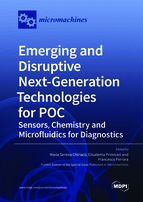Emerging and Disruptive Next-Generation Technologies for POC: Sensors, Chemistry and Microfluidics for Diagnostics
A special issue of Micromachines (ISSN 2072-666X). This special issue belongs to the section "B4: Point-of-Care Devices".
Deadline for manuscript submissions: closed (25 May 2021) | Viewed by 21913
Special Issue Editors
Interests: lab on chip; microfluidics; cancer biology; point-of-care
Special Issues, Collections and Topics in MDPI journals
Interests: lab on chip; microfluidics; microelectronics; in vitro diagnostics; rapid prototyping
Interests: lab on Chip; polymers; sensors; point-of-care; precision medicine
Special Issues, Collections and Topics in MDPI journals
Special Issue Information
Dear colleagues,
The Special Issue will be focused on new, emerging, and disruptive technologies with applications at the Point-Of-Care. The submission of scientific papers and reviews in the field of sensors, chemistry, and microfluidics as well as technological transfer and project management strategies is encouraged.
Recently, the attention paid to self-care tests and on the easy and large screening of a high number of people has dramatically increased. Indeed, the need of easy and affordable tools for the safe management of biological fluids together with self-diagnosis emerged as compulsory requirements in this time of the COVID-19 pandemic, to lighten the pressure on public healthcare institutions and thus limiting the diffusion of infections. Obviously, also other kinds of pathologies (cancer or other degenerative diseases) continue to call attention to an always earlier and widespread diagnosis. The contribution to the development of this research field comes from the areas of innovative plastic and 3D microfluidics, smart chemistry and integration of miniaturized sensors, going in the direction to improve performances of in-vitro diagnostic (IVD) devices.
In our Special Issue, we accept papers describing easy strategies to identify diseases at the Point-Of-Care and near-the-bed level, but also dealing with innovative biomarkers, sample treatments, and chemistry processes which, in perspective, represent promising tools to be applied to the field.
This Special Issue stems from EDGE-Tech (Emerging and Disruptive next-GEneration Technologies for POC) Workshop organized in the frame of EU SMILE-Attract project, devoted to the development of innovative strategies for the early diagnostics of oral cancer from saliva, but submission is open for all researchers and scientists dealing with the above-mentioned topics.
Dr. Maria Serena Chiriacò
Dr. Francesco Ferrara
Dr. Elisabetta Primiceri
Guest Editors
Manuscript Submission Information
Manuscripts should be submitted online at www.mdpi.com by registering and logging in to this website. Once you are registered, click here to go to the submission form. Manuscripts can be submitted until the deadline. All submissions that pass pre-check are peer-reviewed. Accepted papers will be published continuously in the journal (as soon as accepted) and will be listed together on the special issue website. Research articles, review articles as well as short communications are invited. For planned papers, a title and short abstract (about 100 words) can be sent to the Editorial Office for announcement on this website.
Submitted manuscripts should not have been published previously, nor be under consideration for publication elsewhere (except conference proceedings papers). All manuscripts are thoroughly refereed through a single-blind peer-review process. A guide for authors and other relevant information for submission of manuscripts is available on the Instructions for Authors page. Micromachines is an international peer-reviewed open access monthly journal published by MDPI.
Please visit the Instructions for Authors page before submitting a manuscript. The Article Processing Charge (APC) for publication in this open access journal is 2600 CHF (Swiss Francs). Submitted papers should be well formatted and use good English. Authors may use MDPI's English editing service prior to publication or during author revisions.
Keywords
- emerging technologies
- point-of-care
- sample preparation
- 3D microfluidics
- early diagnostics
- large-scale screenings
Related Special Issues
- Research and Development of Point-of-Care Technologies for and after COVID-19 in Micromachines (2 articles)
- Point-of-Care Diagnostic Biosensors in Micromachines (1 article)
- Microsystems for Point-of-Care Testing, Volume II in Micromachines (1 article)
- Micro-/Nano-Technology for COVID-19 and Other Infectious Diseases: Diagnosis, Treatment and Prevention in Micromachines (3 articles)








